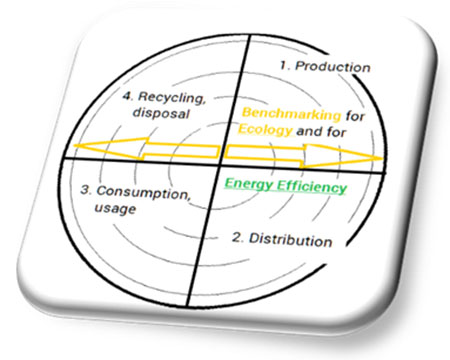The Key Components of CtoBEE
Key Component # 1: The ‘Compass’ – Number
First Method worldwide to cover all 4 phases of Product lifecycle.
Compass in its current version includes the entire product life cycle. It is defined by the following phases to be run through chronologically:
1. Production
2. Trade, Distribution
3. Consumption, usage
4. Recycling, Disposal.
In a later chapter we will have a brief description of each area.


Each phase is rated similarly to the Energy Efficiency Certificate (see above A-G). However, the main parameters are ‘Ecology’ and ‘Energy Efficiency’. Many others can be added depending on the sector (e.g.: 1 Production: Resource Efficiency; 3 Consumer: Bio Certificates).
Definition: Balanced Ecology is understood as an ongoing process of interaction between living species and their physical environment, with the objective of ensuring an adequate long-term habitat for its living species.
If we want to determine if a product is overall beneficial or not from an ecological perspective, we should analyze its impact throughout its lifetime. This impact is being calculated by weighing all sectors and displaying the result as a single number from 0 to 10: The COMPASS.
At a short glance you recognize immediately whether the product contributes (from 6 – 10) to a Balanced Ecology on Earth or destroys it (from 0 – 5,9).


Gradations of Compass-to-Balanced-Ecology on Earth, CtoBEE:

Finally, the customer will have access to relevant product information like an eco-Wiki just by scanning the product-code (comparable the ‘Yuka’-App).
In conclusion, Compass-to-Balanced-Ecology on Earth is a solution that…
1. …helps to orientate and motivate customers in an easy and methodical way.
2. …summarizes product’s life-time impact on ecology, reporting whether it is:
+ improving the ecological balance or
– deteriorating the ecological balance of our global environment.
3. …communicates results at a glance to the customer and is easily understandable.
4. …connects everyone who care about ecology, from individual consumers to the business community and politicians.
5. …has the potential to break the dominance of “price” as a decision criterion for a purchase, in favor of the product criterion “balanced ecology” (comparable to the well-known ‘Quality’, or ‘BIO’ product criteria).
6. …can be implemented worldwide.
7. …is independent of economic or political systems.
8. …can be licensed by the legal entity.
9. …with systematic procedure provides
- feed-back to participants about their products and processes.
- intrinsic focus on continuous improvement of ecology.
10. …is accompanied by ongoing scientific support and supervision.
11. …has a sound theoretical basis (The Manual) to provide guidance in technical, methodical and theoretical issues related to ecology.
12. …ultimately represents a long-term win-win situation for all individuals and organizations involved.
Key Component # 2: Manual & Mindset
What you should know about the Manual of CtoBee.
The “manual” has the task of accompanying the certification in the different areas in a comprehensible and thus standardizable way. It reflects the different areas (production…) as well as all scientific areas that are used for certification. This results in a matrix-like assignment (see figure below). The following topics are covered:
Cross-disciplinary learning as a requirement for education and advanced training
In order to achieve a transformation of the multifaceted and complex challenges into promising business models and socially recognized results, a mix of knowledge and experience is desirable. This may consist of e.g. information technology, ecological marketing, business and economics, social studies, recyclables and waste management, natural sciences (e.g. biology, physics, chemistry). This relation visualizes the following graphics.

Fig.: Linking research disciplines to CtoBEE sectors.

Fig: Linking scientific fields to CtoBEE sectors.
The COMPASS to Balanced Ecology on Earth methodology reflects this interconnected way of thinking.
How ‘Market-Pull’ and CtoBEE work
The customer or end consumer is at the center of CtoBEE’s method. He decides which product to buy. In simple terms, this “buy” decision confirms the work of the manufacturer and retailer. This demand is also referred to as “market pull”. This effect is strongly related to a “Bottom-Up” approach: The customer decides.

Fig.: Feed Back by Customers: “Market Pull”
There are two important criteria for a successful ‘Market Pull’: First, that the consumer can make a decision in favor of ecological products. He can only do this if the majority of products are labeled accordingly and the information is available in a flash and clearly arranged. And secondly, that a sufficiently large number of customers make a decision in the right direction: Product with COMPASS “greater than or equal to 5.9”.

Once this ‘critical mass’ is reached, the ecology of the earth improves continuously. It is only a matter of time until not only equilibrium, but ‘Benefit’ in terms of our business model ‘Earth’ is created.
How is the COMPASS number created?
Product-related, the individual areas (production,….) are analyzed and certified with a COMPASS number according to their ecological degree. At the end, the individual figures are combined and visualized according to their area. Finally, there is a central COMPASS number that gives the product a final rating between 0 and 10. This number is highlighted enlarged. The customer has the possibility to scan the QR or barcode available on the product and get detailed information about the particular composition.
By evaluating each phase of the product life cycle feedback per phase and product is achieved (see. Fig.).

Fig.: Feedback through product life cycle.
CtoBEE's mindset with its 2 key elements is based on the following core elements:
- Collaboration with colleges on international scale
- Focusing on ongoing marketing activities with pedagogical touch, including educational institutions
- Collaboration and exchange of ideas with political bodies, public administration
- Working with pilot companies for initial certifications
- Deploying advanced database system
- Provide headquarter with training facilities
- Performing public “Road Shows” (focused on enterprises and consumer)


